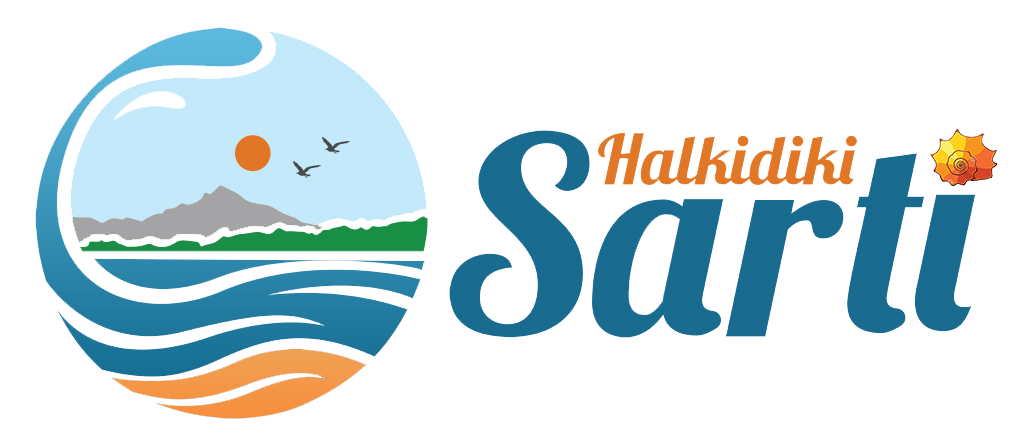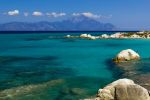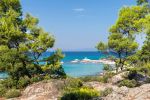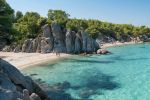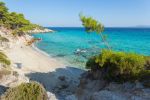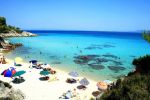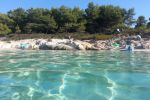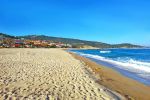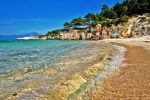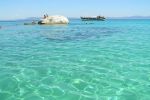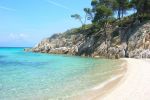Sightseeing
Stagira – Birthplace of Aristoteles
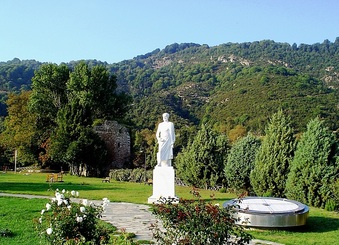 Birthplace of Aristoteles, the greatest philosopher of ancient times and the teacher of Alexander the Great.
Birthplace of Aristoteles, the greatest philosopher of ancient times and the teacher of Alexander the Great.
The city was founded in ca. 655 B.C. by colonists from Andros. After the Persian Wars it joined the First Athenian League, in 424 B.C. it rebelled against it, and during the Peloponnesian War became an ally of the Spartans against Athens. Later, the city joined the Chalkidian League and in 348 B.C. it was captured by king Philip II.
Tradition has it that the inhabitants of Stagira tranferred Aristotle’s relics to the city, buried it there, and founded a festival in his honour, called the “Aristoteleia”.
Recent excavations conducted by the 16th E.P.C.A. have brought to light the early Classical fortification of the city, preserved in very good condition, various public buildings in the Agora (the Classical stoa), an Archaic sanctuary, the Thesmophorion, private houses of the Classical and Hellenistic periods, and the waterworks of the city.
The archaeological site is always open. You can visit follow sites for more informations: ARISTOTLE`S PARK and Ancient Stagira
Acanthus
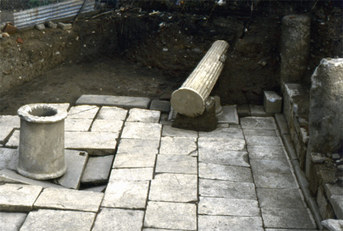 Acanthus was the most important city and harbour of NE Chalkidiki. It was founded in the middle of the 7th century B.C. by colonists from Andros, on the site of a prehistoric settlement. The city extends on a ridge almost 600 m. SE of modern Ierissos and is currently excavated by the 16th E.P.C.A.
Acanthus was the most important city and harbour of NE Chalkidiki. It was founded in the middle of the 7th century B.C. by colonists from Andros, on the site of a prehistoric settlement. The city extends on a ridge almost 600 m. SE of modern Ierissos and is currently excavated by the 16th E.P.C.A.
Sections of the fortification walls of the city are preserved, including an impressive part of the acropolis; the whole area, though, is covered with architectural members and buildings of the Classical and, mainly, the Hellenistic period.
The extensive cemetery of the city, containing some 9000 graves, lies on the shore and was used from the Archaic period (7th, 6th centuries B.C.) until modern times (17th century).
The archaeological site is always open.
You can visit follow site for more informations: Ancient Acanthus
Olynthos
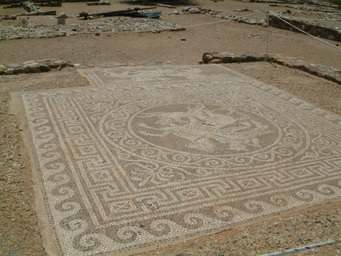 Ancient Olynthos, the most important political centre of Chalkidiki in the Classical period, occupies two hills: on the South Hill lies the city founded by the Bottiaeans in the 7th century B.C., which was destroyed by the Persians in 479 B.C. On the North Hill lies the Classical city, built in the Hippodameian system, with vertically crossing wide and narrow streets, forming regular architectural blocks (87 x 35 m.). Remarkable is the type of the Olynthian house with the “pastas” on the north side of the interior courtyard, surrounded by rooms and auxiliary spaces. Very impressive are the mosaics found in the men’s quarters, which are among the earliest known specimens of the Classsical period.
Ancient Olynthos, the most important political centre of Chalkidiki in the Classical period, occupies two hills: on the South Hill lies the city founded by the Bottiaeans in the 7th century B.C., which was destroyed by the Persians in 479 B.C. On the North Hill lies the Classical city, built in the Hippodameian system, with vertically crossing wide and narrow streets, forming regular architectural blocks (87 x 35 m.). Remarkable is the type of the Olynthian house with the “pastas” on the north side of the interior courtyard, surrounded by rooms and auxiliary spaces. Very impressive are the mosaics found in the men’s quarters, which are among the earliest known specimens of the Classsical period.
The first excavations of the site were conducted in 1928-1938 by the American School of Classical Studies under the direction of Prof. D.M. Robinson. In 1992 the 16th E.P.C.A. undertook the task of the restoration and landscaping of the settlement on the North Hill.
- Open Hours: 08:30 – 15:30
- Ticket price: Full: €3, Reduced: €2
You can visit follow site for more informations: Ancient Olynthos
Toroni – The Lecythus fort
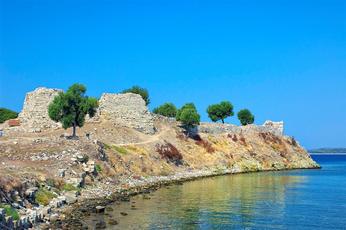 Surveys were conducted by the XVI Ephorate of Classical Antiquities in 1975. The harbour port, Lecythus (Λήκυθος), is being refurbished. The ancient city extends in three main areas: the Acropolis located to the rocky and extremely bluff hill between Porto Koufo and Lecythus, which was connected with the city via long walls; the main ancient city, in the plateau southwest of acropolis up to the coast, that includes Lecythus fort; and the Proasteion (suburb) of the city, in today’s narrow, but in antiquity much broader neck of land that connects Lecythus and the city.In Mythological Times Toroni was the wife of Proteus, son of Poseidon. There are traces of prehistoric settlements dating from the third millennium before Christ and many other relics of ancient, Early Christian and Byzantine monuments, which bear witness to the fact that the area is continuously inhabited since the Neolithic Age. Ancient Toroni was founded by colonists from Chalkida in the 8th century BC. By the 5th century BC Toroni was already one of the most important cities in Chalkidiki. It had its own coin and was a member of the Delian League. Thucydides narrates that in 423BC Toroni was taken over by Spartan officer Brasidas. In 348BC the city was annexed to the state of Philip II of Macedon. In 168BC it was conquered by the Romans and the city fell into decline.In the Byzantine Era the area comprised of monastery dependencies, belonging to the monasteries on Holy Mt. Athos. Its mighty walls and other buildings were destroyed in the 19th century, when the Turks used the granite to pave central avenues in Constantinople and Thessaloniki. Findings from recent excavations confirmed the continuous habitation of the area since the end of the Neolithic Age up until the Ottoman Era. Architectural remains have been uncovered, however of a very fragmentary nature, since most were destroyed due to the continuous use of the space. The archaeologists placed particular emphasis on the cemetery of the settlement from the Iron Age, which is held to cover a period extending from late 2nd century until the middle of the 9th century. 134 tombs were uncovered in this cemetery, of which 118 contained ashes while 16 contained simple burials. 500 vessels also came to light, which were used either as urns or burial gifts.
Surveys were conducted by the XVI Ephorate of Classical Antiquities in 1975. The harbour port, Lecythus (Λήκυθος), is being refurbished. The ancient city extends in three main areas: the Acropolis located to the rocky and extremely bluff hill between Porto Koufo and Lecythus, which was connected with the city via long walls; the main ancient city, in the plateau southwest of acropolis up to the coast, that includes Lecythus fort; and the Proasteion (suburb) of the city, in today’s narrow, but in antiquity much broader neck of land that connects Lecythus and the city.In Mythological Times Toroni was the wife of Proteus, son of Poseidon. There are traces of prehistoric settlements dating from the third millennium before Christ and many other relics of ancient, Early Christian and Byzantine monuments, which bear witness to the fact that the area is continuously inhabited since the Neolithic Age. Ancient Toroni was founded by colonists from Chalkida in the 8th century BC. By the 5th century BC Toroni was already one of the most important cities in Chalkidiki. It had its own coin and was a member of the Delian League. Thucydides narrates that in 423BC Toroni was taken over by Spartan officer Brasidas. In 348BC the city was annexed to the state of Philip II of Macedon. In 168BC it was conquered by the Romans and the city fell into decline.In the Byzantine Era the area comprised of monastery dependencies, belonging to the monasteries on Holy Mt. Athos. Its mighty walls and other buildings were destroyed in the 19th century, when the Turks used the granite to pave central avenues in Constantinople and Thessaloniki. Findings from recent excavations confirmed the continuous habitation of the area since the end of the Neolithic Age up until the Ottoman Era. Architectural remains have been uncovered, however of a very fragmentary nature, since most were destroyed due to the continuous use of the space. The archaeologists placed particular emphasis on the cemetery of the settlement from the Iron Age, which is held to cover a period extending from late 2nd century until the middle of the 9th century. 134 tombs were uncovered in this cemetery, of which 118 contained ashes while 16 contained simple burials. 500 vessels also came to light, which were used either as urns or burial gifts.
The archaeological site is always open. You can visit follow site for more informations: http://en.wikipedia.org/wiki/Toroni
Archaeological Museum of Thessaloniki
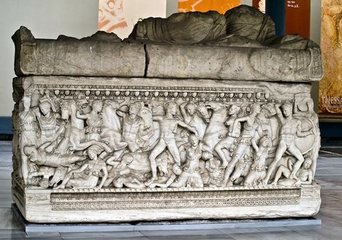 At present, the collection of Archaic to Late Roman sculptures from Thessaloniki and Macedonia in general is displayed in the central section of the museum. They illustrate the history of Thessaloniki from prehistoric times to Late Antiquity. These rooms display architectural members from an Ionic temple of the 6th century bc, sculptures of all periods from Macedonia, exhibits from the excavations in the palace complex built by Galerius in Thessaloniki city centre, a reconstruction of the facade of the Macedonian tomb in Ayia Paraskevi, Thessaloniki prefecture, with genuine architectural members, and finds (mainly gold artefacts) of the Archaic and Classical periods from the Sindos cemetery. In all these rooms, certain important exhibits have been singled out and further information about them is given to help visitors appreciate the importance of each exhibit and of the area and the period from which it comes.
At present, the collection of Archaic to Late Roman sculptures from Thessaloniki and Macedonia in general is displayed in the central section of the museum. They illustrate the history of Thessaloniki from prehistoric times to Late Antiquity. These rooms display architectural members from an Ionic temple of the 6th century bc, sculptures of all periods from Macedonia, exhibits from the excavations in the palace complex built by Galerius in Thessaloniki city centre, a reconstruction of the facade of the Macedonian tomb in Ayia Paraskevi, Thessaloniki prefecture, with genuine architectural members, and finds (mainly gold artefacts) of the Archaic and Classical periods from the Sindos cemetery. In all these rooms, certain important exhibits have been singled out and further information about them is given to help visitors appreciate the importance of each exhibit and of the area and the period from which it comes.
- Open Hours: Monday: 13.30-20.00, Tuesday- Sunday: 08.00-20.00
- Ticket Prices: General: €6, Students: free, Senior citizens: 4€
- Adress: 6 Manolis Andronikos St., GR 54621, Thessaloniki, Macedonia, Greece.
You can visit follow site for more informations: http://www.amth.gr
Museum of Byzantine Civilisation of Thessaloniki
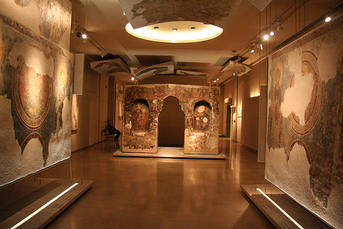 The museum has collections of sculpture, frescoes, mosaics, icons, and inscriptions from the Byzantine period. It has permanent exhibitions, rooms for temporary thematic exhibitions, conservation workshops, and storerooms. The exhibits include sculptures, wall paintings, mosaic floors, icons, metalwork, coins, inscriptions, glassware, and pottery.
The museum has collections of sculpture, frescoes, mosaics, icons, and inscriptions from the Byzantine period. It has permanent exhibitions, rooms for temporary thematic exhibitions, conservation workshops, and storerooms. The exhibits include sculptures, wall paintings, mosaic floors, icons, metalwork, coins, inscriptions, glassware, and pottery.
At the moment, three permanent exhibitions are open, presenting aspects of the society and the art of the Early Christian period (4th–7th cent. ad) with emphasis on the transition from the ancient world to Christianity.
The subject of the first exhibition is Early Christian Churches, and it focuses on the design and the decoration of churches in the first centuries after Christianity triumphed. Outstanding exhibits include the ambo from the basilica by the Philippi Museum (6th cent. ad), a mosaic floor from a basilica found north of the Church of the Taxiarchs in Thessaloniki’s Upper Town (6th cent. ad), and an arch and piers from the Church of St Demetrios in Thessaloniki.
The subject of the second exhibition is Early Christian Cities and Dwellings, and it presents various aspects of economic life, domestic handicrafts, houses and their fixtures and fittings, as also details of food and clothing. The centre of the room is occupied by the reception room of a house with a mosaic floor and well preserved wall paintings imitating marble revetment. Other exhibits include amphoras that were used for trade in oil and wine and such everyday objects as ceramic ware, oil lamps, sewing and weaving equipment, and jewellery.
The third exhibition is titled From the Elysian Fields to the Christian Paradise, and it focuses on Early Christian cemeteries, sepulchral architecture and painting, cult customs, jewellery, and glass and clay vessels from excavated graves. There are tombs with painted decoration from Thessaloniki’s east and west cemeteries, epitaphs, sarcophagi, statues, and sculptures, and glassware and jewellery from graves (2nd–6th cent. ad).
- Open Hours: Monday: 13.30-20.00, Tuesday-Sunday: 08.00-20.00
- Ticket Prices: General: €4, Students: free, Senior citizens: 2€
- Adress: 2, Stratou Av., GR 54013, Thessaloniki, Macedonia, Greece.
You can visit follow site for more informations: www.mbp.gr
The White Tower of Thessaloniki
T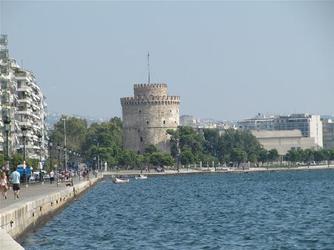 he symbol of Thessaloniki, the White Tower is a 15th century fortification which was part of the city’s defences at the point where the seaward defence and the eastern wall met. Originally the barracks for the city’s sentries, in later years it served as a prison for condemned prisoners awaiting execution. It was reconstructed early in the 1980s and has functioned as a museum since 1985.Today the White Tower is used as the exhibition space of the Byzantine Museum of Thessaloniki. For the first few months of 2002 it housed ‘Byzantine Hours’, an exhibition devoted to ordinary life in Byzantine times.
he symbol of Thessaloniki, the White Tower is a 15th century fortification which was part of the city’s defences at the point where the seaward defence and the eastern wall met. Originally the barracks for the city’s sentries, in later years it served as a prison for condemned prisoners awaiting execution. It was reconstructed early in the 1980s and has functioned as a museum since 1985.Today the White Tower is used as the exhibition space of the Byzantine Museum of Thessaloniki. For the first few months of 2002 it housed ‘Byzantine Hours’, an exhibition devoted to ordinary life in Byzantine times.
- Open Hours: Tuesday-Sunday: 08.30-15.00, Monday: closed
- Ticket Prices: Adults: €3, Children: Free, Senior citizens: €2
You can visit follow site for more informations: www.lpth.gr
Petralona Caves
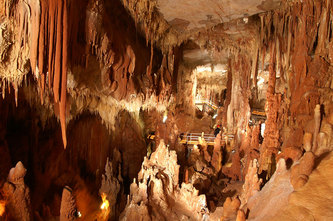 The bejewelled with stalagmites and stalactites Petralona Cave is formed about 300 m above sea level. The Cave was spotted the first half of the 20th century by the inhabitant of the Petralona village Philippos Chatzaridis (1892-1981), through an ovoid 0,7 m long fracture of the limestone Kalavros Mountain, which in its turn is created during Jurassic era (~150 million years) by undersea calcite sediments that emerged later on in various phases. Most probably during Mio-Pleiocene, about 5 million years ago, the Cave’s main compartments were formed.Internationally the Cave became known by the autumn of 1960, when another villager, Christos Sariannidis (1931-2001) along with five other men (three of whom scientists), found the famous fossilized skull of Petralona man.His research proved that Petralona Archanthropus (i.e. an archaic Homo sapiens) has an age of about 700.000 years ago, representing the oldest known Europeoid man. The above chronology is based on the detail analysis of the Cave Stratigraphy (until today 34 geological layers have been unearthed), as well as the study of the Palaeolithic tools and the Palaeofauna species that have been discovered in almost all layers. Among the fossils of the extinct species found in the Cave, lions, hyenas, bears, panthers, elephants, rhinos, megacerines, bisons, and various species of dears and equids (horse like) are included, as well as 25 species of birds, 16 species of rodents and 17 species of bats.
The bejewelled with stalagmites and stalactites Petralona Cave is formed about 300 m above sea level. The Cave was spotted the first half of the 20th century by the inhabitant of the Petralona village Philippos Chatzaridis (1892-1981), through an ovoid 0,7 m long fracture of the limestone Kalavros Mountain, which in its turn is created during Jurassic era (~150 million years) by undersea calcite sediments that emerged later on in various phases. Most probably during Mio-Pleiocene, about 5 million years ago, the Cave’s main compartments were formed.Internationally the Cave became known by the autumn of 1960, when another villager, Christos Sariannidis (1931-2001) along with five other men (three of whom scientists), found the famous fossilized skull of Petralona man.His research proved that Petralona Archanthropus (i.e. an archaic Homo sapiens) has an age of about 700.000 years ago, representing the oldest known Europeoid man. The above chronology is based on the detail analysis of the Cave Stratigraphy (until today 34 geological layers have been unearthed), as well as the study of the Palaeolithic tools and the Palaeofauna species that have been discovered in almost all layers. Among the fossils of the extinct species found in the Cave, lions, hyenas, bears, panthers, elephants, rhinos, megacerines, bisons, and various species of dears and equids (horse like) are included, as well as 25 species of birds, 16 species of rodents and 17 species of bats.
- Open Hours: 09:00 to 18:00
- Ticket Price: General: €7, Students: €4
You can visit follow site for more informations: www.petralona-cave.gr











